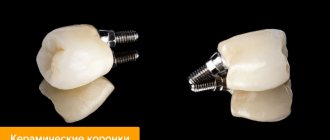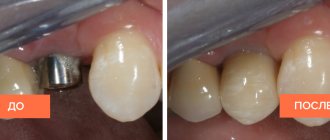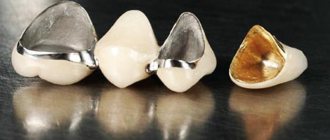The incisors and canines make up the smile line; any damage or defect in this area becomes immediately noticeable. Restoration and reconstruction of the frontal group of teeth is the most complex process of all clinical options. When replacing the supragingival part of a tooth with an artificial crown, it is necessary to achieve a harmonious combination with the adjacent units and soft tissues. The best crowns for the front teeth should have a natural shade and degree of transparency, like real incisors. At the same time, be not only beautiful, but also quite durable.
Orthopedic dentistry uses different methods, technologies and materials to restore the frontal group of teeth. The doctor decides which crowns to put on the front teeth and which method of prosthetics to choose based on the clinical situation. The patient is offered several treatment options, from which he chooses the optimal one in terms of aesthetics and cost. The physical and optical properties of restoration materials are well studied today, which greatly simplifies the choice. An integrated approach to treatment allows you to create prosthetic structures with individual optical characteristics, achieving the best aesthetic result.
Smile zone: indications for installing crowns
When communicating and expressing emotions, the teeth in the frontal region are involuntarily exposed. Their condition is visible to others, and this can cause psychological discomfort. If you are not happy with the appearance of your front incisors, contact your dentist. Even in the most advanced cases, when teeth are severely damaged, it is not necessary to remove them. After a thorough diagnosis, the doctor may recommend restoring teeth with crowns. A cap-like structure is placed over the remaining part of the tooth and takes over its functions.
Restoration with crowns is indicated in the following cases:
- aesthetic defects (chips, stains, cracks, diastemas, trema, curvature, etc.);
- single or complete destruction of teeth with preservation of the root;
- uneven gum line;
- bite pathology;
- pathological abrasion and discoloration of enamel;
- restoration of lost functions (biting, sharing food, diction).
The front incisors are not associated with the chewing function, so there are no strict requirements for the strength of the crowns. The doctor’s task is to recreate the anatomical shape and color of natural teeth, maintain their degree of transparency, and achieve a perfect match of sizes.
Options for restoration of the anterior region with crowns
For patients and dentists, the front teeth have always been the most problematic. In the last century, people were given metal crowns to preserve chewing function. There were no other alternatives. Such structures coped with the chewing function, but looked very unaesthetic, oxidized, caused allergies and galvanic syndrome (taste in the mouth). The most expensive and fashionable were gold dentures. Products made of ductile metal did not oxidize, did not cause rejection, and did not wear out for a long time. But the shiny yellow crowns were conspicuous and did not look like natural teeth, so over time, fashion changed, and this restoration technology was replaced by more modern techniques.
Today, patients have the opportunity to painlessly and quickly get rid of all defects associated with damage or loss of teeth in the frontal area, including the complete absence of dentition. In shape, shade and transparency, artificial analogs are almost no different from natural teeth, and their strength allows you to forget about any problems for a long time.
Ceramic veneering
Veneers are usually placed when the front teeth are slightly crooked. Dental veneers are installed very quickly, without the need for invasive procedures, and patients who decide to correct crooked teeth with veneers do not experience pain or discomfort. If you are looking for an option to correct crooked teeth for an adult patient, it makes sense to consider porcelain veneers. What you need to understand:
- Veneers cannot be placed on one or two teeth - the entire frontal zone (6-8 teeth) is treated.
- The cost of veneering will be higher than with prosthetics for one tooth, but the result will be the envy of Hollywood stars. The price of a veneer for 1 tooth according to the promotion at Amazing Price Dentistry is 12,500 rubles.
- Correcting crooked teeth with veneers will require 3 visits to the clinic.
Types of dental crowns
In any clinic, patients can choose the type of future crown themselves, but without the help of a doctor it is very difficult to understand the types of prostheses, as well as evaluate the advantages and disadvantages of orthopedic structures. When choosing a crown, it is important to know what material it is made of.
✔
Metal ceramics.
✔
Solid ceramic.
✔
Ceramics E-max.
✔
Ceramic coated zirconium.
Metal ceramics
Products of this type have a very solid base. They create structures by alloying various metals: chromium, nickel, cobalt, gold, titanium. To make the dental crown look natural, the metal base is covered with ceramics. Layers are applied to the frame, after which the crown is fired to impart strength and integrity.
- Acceptable cost
- Wear resistance.
- Reliability.
- Change in color of soft tissues.
- Allergy to metal.
- Blueness of the gums.
- Significant grinding of the tooth.
Solid ceramic
When restoring teeth in the frontal zone, doctors recommend all-ceramic structures for aesthetic single prosthetics. All-ceramic crowns are made from pressed ceramic without the addition of additional materials. These are quite fragile products, so they are not used in the chewing department.
- Biocompatibility.
- Great aesthetics.
- Durability.
- Fragility.
- Impossibility of performing bridge prosthetics.
- Relatively high price.
E-max ceramics
The problem of the fragility of a material such as ceramics was solved by glass-ceramic crowns E-max. They are not only very durable, but also distinguished by high aesthetics. This is an excellent option for front teeth. The E-max crown looks natural and does not stand out among natural teeth.
- Strength.
- Aesthetics.
- Reliability.
- Natural transparency.
- High price.
Zirconium
In the popularity rating, zirconium crowns have been occupying first place for several years. In terms of strength, aesthetic products made from zirconium dioxide are not inferior to metal, which makes it possible to create orthopedic structures of the highest quality. The hard material enhances the strength of teeth and restores their size and shape.
- Excellent biocompatibility and thermal conductivity.
- Inertness of the material.
- Kink resistance.
- Lack of natural transparency.
- High price.
Ceramic crowns on a zirconium frame
This type of crown is an excellent opportunity to combine strength, reliability, and high aesthetics. The products are as reliable and durable as metal-ceramic crowns. They do not deform during use and serve for a long time. The ceramic layer gives the artificial tooth a natural appearance.
- They look natural.
- Hypoallergenic.
- Withstands heavy loads without risk of damage.
- Quite a high cost.
Which crown is better to put?
Based on the materials used, the following types of crowns are distinguished.
Sitall
Crowns made of glass-crystalline materials are biologically inert, i.e. do not cause adverse clinical manifestations. Dentures resist the chewing load well, are quite elastic, and have increased resistance to the corrosive effects of aggressive agents. The main disadvantage is fragility. Recommended for allergy sufferers and chronically ill people (due to the consumption of a large number of medications, they should avoid anything that can provoke an allergy or cause a rejection reaction).
Porcelain (ceramics)
Standard porcelain “caps” are made with a stably fixed or separate metal pin (the second option is more convenient). A more expensive option is custom-made prostheses based on a platinum matrix. After 2 annealings, a stage of shape correction between them, the individual characteristics of the teeth (cracks, stains) are imitated on the surface. Then they are tinted with majolica glazes, securing with another annealing. Then the “cap” will look natural.
Porcelain crowns
The main disadvantages of porcelain fixed dentures:
- fragility;
- poor marginal fit;
- abrade the surface of antagonist teeth.
They are chosen by people who have high aesthetic requirements for the oral cavity (show business). Ceramic dentures are also used for those who cannot undergo restoration with a composite. If the occlusal load is distributed unevenly, the dentist will suggest a different material.
Metal
More than 500 alloys are used in dentistry, but most metal fixed dentures are made of chromium-nickel or silver-palladium alloy, as well as 900 gold with the addition of copper, silver, and platinum as a ligature.
Metal “caps” are resistant to alkali and acid (in small concentrations), have high wear resistance, are moderately elastic, and are relatively biologically indifferent. The fashion for the “gold tooth” is back. Metal prostheses are durable products that do not require special attention. The retention time of the properties of a metal crown depends on the alloy.
Zirconium dioxide
These are the most popular of all fixed types of prostheses. Zirconium oxide (or dioxide, in the formula there are 2 oxygen molecules per molecule of zirconium) is chosen by public figures. The process of making a “cap” is labor-intensive, using computer modeling, so the product is expensive. This is a category of elite prosthetics.
The crown is durable, its color and transparency are very similar to a real tooth. In terms of all the characteristics of medical implants (bioinertness, resistance to acid-base influence, elasticity) it is one of the best.
There are 2 types of crowns:
- with the application of ceramics, when metal is used as a base;
- without porcelain, then the desired shade is manually applied to it.
Advantages of zirconium fixed prostheses:
- Making fairly thin crowns with minimal grinding (this way the teeth remain alive).
- Accuracy of fit (computer modeling is used).
- The service life of crowns is from 10 to 20 years.
- High aesthetics. In terms of transparency and structure, they best match natural teeth.
- Strength. They are made for both front and chewing teeth.
- Biocompatibility.
- High precision in the manufacture of crowns allows you to achieve the tightest possible fit, avoiding the inflammatory process and the development of caries.
Metal ceramics
This is a good alternative to porcelain crowns, since metal-ceramic prostheses are characterized by:
- increased strength;
- better fit at the edges.
Metal ceramics
A metal alloy is used for the base, and a ceramic mass is applied to it. The best base is gold, in which case the base is thin, freeing up more space for ceramics. The metal will not show through the porcelain - this makes your smile look more natural. But there is a nuance: it is highly undesirable to install several fixed dentures (or a base with ceramics) made of different metals. For installation, deep preparation is used only on the vestibular surface (this is the side of the tooth turned towards the lips and cheeks) to mask the frame of the prosthesis.
Contraindications to installing metal-ceramic crowns on teeth:
- Teeth with thin crowns, when there is a risk of pulp damage.
- Deep blocking or wearing away bite.
- Pathological abrasion of tooth tissues.
- Parafunctions of the masticatory muscles, in which there is high muscle excitability, bruxism, and lateral displacement of the jaw.
Please note: it is better to avoid metal-ceramic crowns if you have marginal periodontal diseases, because Patients regularly experience functional overload of teeth, which leads to exacerbation of inflammation and deepening of the destruction process.
Metal-plastic
The second name for “caps” is combined, because Composed of plastic, composite, porcelain. These are temporary “caps” since the service life usually does not exceed 3 years. Plastic deteriorates over time under the influence of acids and alkalis, and can be colored with natural food dyes (wine). Summary: not bad, as a temporary option (there are situations, for example, injury, accident, but tomorrow you need to speak, be at negotiations).
Plastic
With good aesthetic properties, a plastic fixed prosthesis is inferior to its analogues in strength. It is not used to restore thin or flat incisors, with a deep or receding bite, pathological abrasion of teeth, or some dentition defects. This type of crown should not be placed on people with allergies.
Fixed dentures are made in 2-3 layers on an interpenetrating polymer mesh. They are recommended for prosthetics for children, during the correction of dentoalveolar anomalies, during periods of primary and mixed dentition.
Temporary crowns made of plastic
How is prosthetics performed: stages of crown installation
Restoring teeth in the smile area is no different from restoring chewing units. The doctor performs standard procedures, but does so taking into account high aesthetic requirements. Crowns in the smile area should restore all lost properties of the tooth: color, shape, size, functionality. For prosthetics to be successful, the procedure is carried out in several stages.
- When restoring a natural tooth, the doctor carries out preliminary treatment: removes caries, bleeding, plaque, changes old fillings, cleans root canals, etc. After all dental problems have been eliminated, if necessary, a support for the crown is installed. A stump tab or a special pin is used as a supporting element.
- The tooth is ground to the required size and an impression is taken, from which a plaster model of the crown is made in the laboratory. To protect the ground element, the patient is given a temporary crown.
- Using special cement, the finished crown is fixed to the front tooth. Well-installed structures should not differ in shape and color, put pressure on antagonist teeth, or cause the sensation of the presence of a foreign body in the mouth. If prosthetics are performed professionally, the patient quickly gets used to the new artificial teeth.
Note!
If you experience discomfort or pain in your mouth, visit your dentist. The doctor will take an x-ray, which will help determine what the problem is and whether the crown needs to be removed to solve it.
Taking impressions.
The next stage after preparation is taking impressions of the tooth. Sometimes this stage is postponed to the next visit a few days after preparation. And that's why. During the preparation process, the doctor is often forced to touch the gum with the drill, injuring it and causing slight bleeding, especially if the tooth previously had subgingival carious cavities. Blood itself interferes with high-quality impression taking, because... Impression materials do not really like excess moisture and therefore the most important area - the ledge around the tooth - may not appear very accurately on the impression. In addition, in some people, the gums have a tendency to recede at the slightest trauma*. And if you take an impression immediately and use it to make a crown, then already at the moment of placing it (or, what is even more unpleasant, a little later) it may turn out that the gum has “run away” and the edge of the crown (especially a metal-ceramic one) sticks out unsightly above the gum.
This is what crowns can look like in a short time if you are not very careful with the gums. For the lateral teeth, “gum loss” may not be so critical, but in the anterior section it will definitely catch the eye of anyone...
The process of taking an impression looks like this: the doctor first places a special thread between the tooth and the gum with a tool in order to move the gum back and get a clear imprint of the formed ledge (sometimes, especially in the case of making metal-free crowns, the ledge is located so that there is no need to place the thread).
The thread that the doctor places in the groove between the gum and the tooth must “squeeze” the gum to the side so that the impression material can completely remove the ledge. Without it, in most cases, you cannot get a high-quality print. Any errors in the fit of the edge of the crown to the ledge will lead to the accumulation of plaque, bad breath and ultimately reduce the life of the crown and the tooth underneath...
The surface of the tooth being removed is thoroughly dried. Next, the doctor uses a special gun to squeeze out the liquid impression mass directly onto the tooth, while the assistant prepares a denser impression mass (like plasticine) and, using a special spoon, all this deliciousness is placed in the mouth for 2-3 minutes until it hardens completely. With a little effort, after a couple of minutes, the spoon with the resulting imprint is taken out into the light - the exact imprint of the tooth is ready!
Is it possible to install a crown if there is no natural tooth?
In the absence of natural teeth, the integrity of the front row can be restored using implants. Carrying out implantation does not require turning of adjacent elements. The crown is placed immediately after the implantation of the artificial root. This process can last from 2 months to six months.
Before installing implants, the doctor takes impressions or conducts three-dimensional computer modeling to obtain a virtual model of the future structure. Before the permanent prosthesis is fixed, the doctor places a temporary crown on the patient.
Correction of crooked teeth - where to go?
A distinctive feature of Amazing Price Dentistry is an individual and comprehensive approach. During dental treatment, these problems as a whole are taken into account, not focusing only on its immediate solution, but on eliminating the cause. A holistic approach is provided by a multidisciplinary team of experts representing specific areas of dentistry, ensuring the best possible results. Teamwork and multidisciplinary consultations significantly reduce the risk of unwanted complications during treatment, and careful planning makes the process clear and transparent for the patient. If you are looking for a clinic that provides treatment in accordance with the highest international standards, we are waiting for you at any convenient time.
Do you have crooked teeth? What to do? – experienced Moscow specialists at Amazing Price Dentistry know. Make an appointment by phone, and dentistry together with the patient will find a solution that suits you in terms of execution time, effect and price.
Author:
Mayorov Andrey Mikhailovich
Specialization:
orthopedic dentistry, dental prosthetics, implant installation
Veneers or crowns: which is better?
You can restore your front teeth using veneers. Non-removable pads are attached to the turned elements. The procedure is much faster than prosthetics, but before making the final choice between veneers and crowns, consult your doctor. Durable ceramic onlays are classified as restoration methods in cosmetic (aesthetic) dentistry. Veneers that protect the surface of the tooth accurately imitate enamel, hiding all imperfections, but in case of significant damage and destruction they are not used. In these cases, crowns are installed.
Crown for front tooth: prices in Moscow
The cost of crowns is not affected by the type of teeth being restored, that is, it does not matter which elements the doctor prosthetizes, upper or lower. The price depends on the number of artificial crowns, the method of their installation, the material, and accompanying therapeutic procedures.
Information on the cost of treatment services can be found on the websites of dental clinics. We present average figures for Moscow.
The price of installing one metal-ceramic crown starts from 9,000 rubles. The cost of ceramic products is from 20,000 rubles. Costs for installing zirconium crowns start at 25,000 rubles. While the permanent crown is being made, the patient wears a temporary structure; it costs 1,500–2,000 rubles.
Composite veneering as a way to correct crooked teeth
Composite restoration is called composite veneering, but this procedure has many differences from installing onlays on teeth.
- Composite restoration is the most affordable way to correct crooked teeth for adults and children. Depending on the amount of material used, the cost will vary between 3500-5500 rubles.
- Only the problematic tooth is subject to intervention. Other units are not turned.
- You can correct crooked teeth with composite in one visit.
- The durability of composite restorations is inferior to ceramic prostheses (veneers or crowns), but with high-quality care and careful handling, a new “straight” tooth will last a long time.










